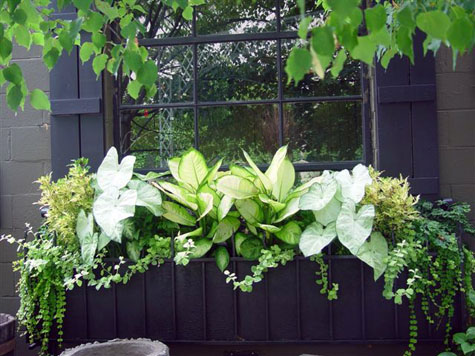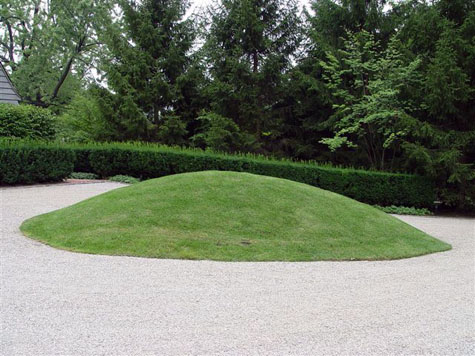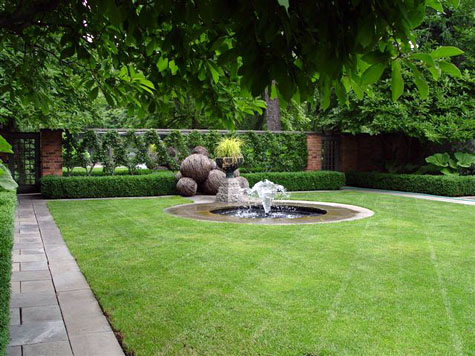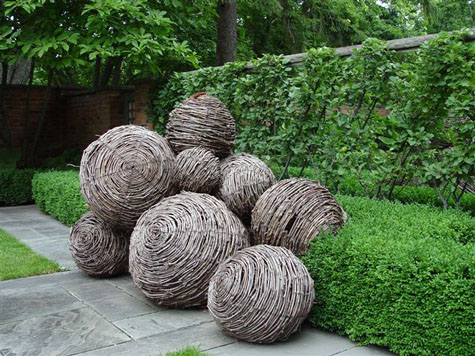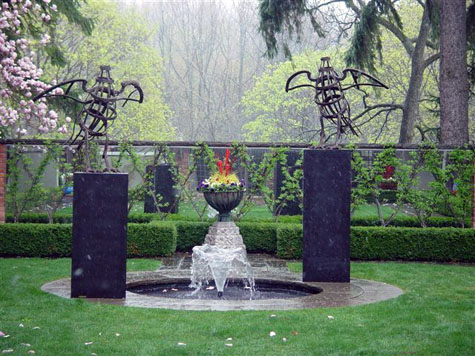Sometimes  I am dealt plenty, when I am asked to design for a client. Although the immediate concept of flat ground seems simple, the solutions can be time consuming and messy. This property was extreme in its high grade- a fence included- on the lot lines. This home-in a ditch.
I am dealt plenty, when I am asked to design for a client. Although the immediate concept of flat ground seems simple, the solutions can be time consuming and messy. This property was extreme in its high grade- a fence included- on the lot lines. This home-in a ditch.
 Can you see-how this client’s land is high at its edges, draining to the house? There was always soil and bark on the drive after a rain. And water standing next to the foundation, and in the garage. Sometimes it seems to me that a house is set too low in the ground; this house was a good candidate for a landscape that would improve many conditions-as water is not good for a house. Slopes are great for sledding or skiing, but not so great for living in. Flat gound makes for sociable spaces. I myself have no interest in juggling a glass of wine, and an appetizer on a hill. I like level. Or As close to level as I can get, and still have drainage. Steeply sloping sites are tough to negotiate, and tough to plant. If you have a space you wish only to view-plant that hill. If you plan to live in that space, terrace it.
Can you see-how this client’s land is high at its edges, draining to the house? There was always soil and bark on the drive after a rain. And water standing next to the foundation, and in the garage. Sometimes it seems to me that a house is set too low in the ground; this house was a good candidate for a landscape that would improve many conditions-as water is not good for a house. Slopes are great for sledding or skiing, but not so great for living in. Flat gound makes for sociable spaces. I myself have no interest in juggling a glass of wine, and an appetizer on a hill. I like level. Or As close to level as I can get, and still have drainage. Steeply sloping sites are tough to negotiate, and tough to plant. If you have a space you wish only to view-plant that hill. If you plan to live in that space, terrace it.
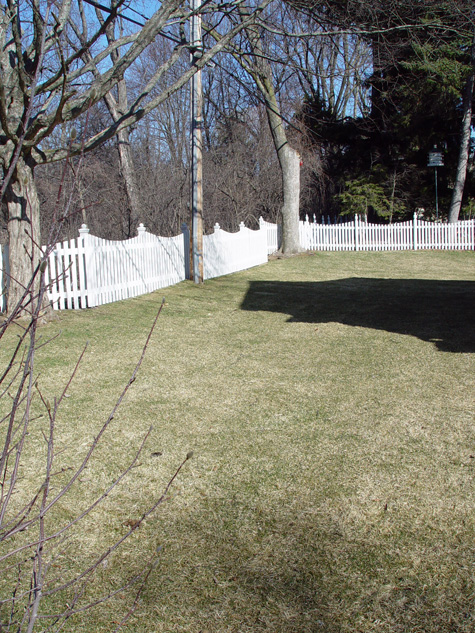 This clients fence was set a good 40 inches above the grade of their house. Water rushed down and covered a terrace that was too small for company anyway. I proposed that they tear the entire space to pieces, and put it back together in such a way that would make their outdoor living and entertaining a breeze.
This clients fence was set a good 40 inches above the grade of their house. Water rushed down and covered a terrace that was too small for company anyway. I proposed that they tear the entire space to pieces, and put it back together in such a way that would make their outdoor living and entertaining a breeze.
 We got to work building retaining walls some seven feet off the lot line, and flattening the land near the house. Of course we had to install drainage to handle the water that deluged their property from the adjacent houses. A transformation of this scale is big messy work-they were fine with it.
We got to work building retaining walls some seven feet off the lot line, and flattening the land near the house. Of course we had to install drainage to handle the water that deluged their property from the adjacent houses. A transformation of this scale is big messy work-they were fine with it.
 So many machines, so much stone for the retaining walls, so much mess.
So many machines, so much stone for the retaining walls, so much mess.
 Heavy rains interrupted our work. No drains were in place yet. Looking at all this water, I did explain to my client how they could see all the water on their property, as a layer of grass no longer covered it up. We did a series of drains that took water to the street, and away from the back yard. Its about as much fun to spend money installing drainage as replacing a furnace-only more expensive. But in this case, the threat of water damage to the house was considerable, and this expense necessary-even if they never went outdoors.
Heavy rains interrupted our work. No drains were in place yet. Looking at all this water, I did explain to my client how they could see all the water on their property, as a layer of grass no longer covered it up. We did a series of drains that took water to the street, and away from the back yard. Its about as much fun to spend money installing drainage as replacing a furnace-only more expensive. But in this case, the threat of water damage to the house was considerable, and this expense necessary-even if they never went outdoors.
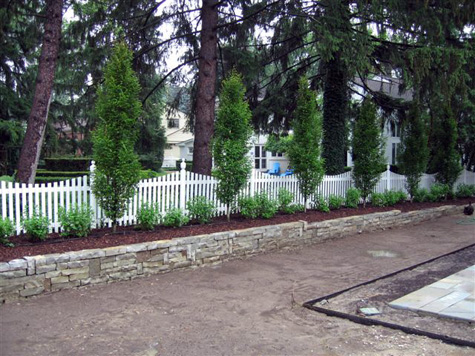 This upper level terrace-we planted with columnar carpinus, and Limelight hydrangeas. This simple planting gave them privacy in a lively way. A terrace double the size of the original made sure that any amount of entertaining they had a mind to do would be handled adequately by the landscape. This project was a big fluid mess for better than 3 weeks. The outcome-level.
This upper level terrace-we planted with columnar carpinus, and Limelight hydrangeas. This simple planting gave them privacy in a lively way. A terrace double the size of the original made sure that any amount of entertaining they had a mind to do would be handled adequately by the landscape. This project was a big fluid mess for better than 3 weeks. The outcome-level.
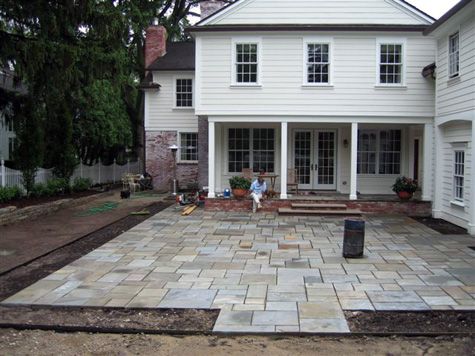
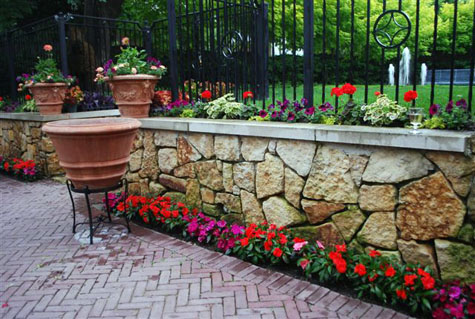 I know I posted however many days ago, that I was planting my pots purple and orange. Sounds hideous, doesn’t it? I was cringing as much as I was looking forward to it. I got the first sonic orange New Guinea impatiens in the ground, and thought I would throw up. Someone years ago told me orange was the color of hysteria-and I was starting to believe it. Could I come home and be charmed by hysteria generated by my own hand?
I know I posted however many days ago, that I was planting my pots purple and orange. Sounds hideous, doesn’t it? I was cringing as much as I was looking forward to it. I got the first sonic orange New Guinea impatiens in the ground, and thought I would throw up. Someone years ago told me orange was the color of hysteria-and I was starting to believe it. Could I come home and be charmed by hysteria generated by my own hand?
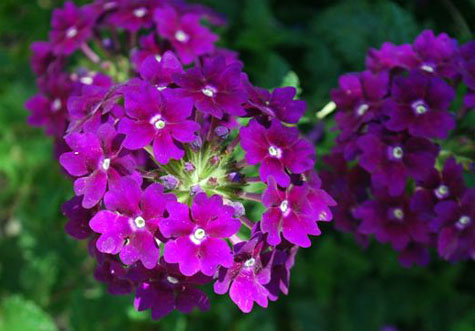
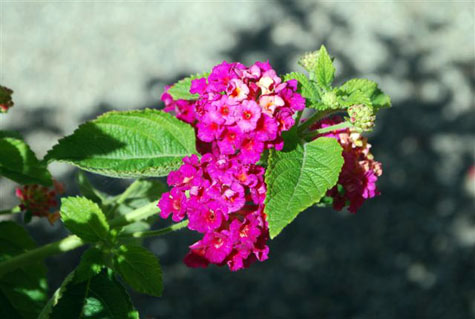
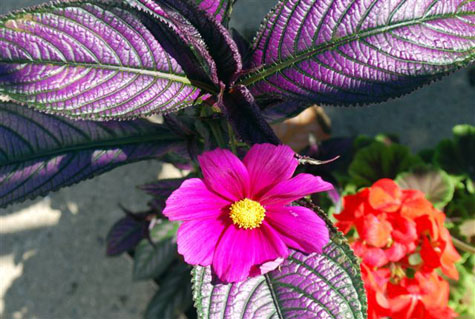

 Texture is such an exciting element in plants-and plantings. Defined by Wikipedia as “an identifying quality”, or the “appearance and feel of a surface”, the texture of a plant can be about its appearance. Some plants are shiny leaved; some have felted leaves. Some leaves and flowers are thin (sometimes referred to as “substance”) and some are thick and juicy looking. Some leaves are wisy and airy looking-others are big and broad-and look as though even a big wind wouldn’t disturb them. This kale is ultra-crinkled-beautiful.
Texture is such an exciting element in plants-and plantings. Defined by Wikipedia as “an identifying quality”, or the “appearance and feel of a surface”, the texture of a plant can be about its appearance. Some plants are shiny leaved; some have felted leaves. Some leaves and flowers are thin (sometimes referred to as “substance”) and some are thick and juicy looking. Some leaves are wisy and airy looking-others are big and broad-and look as though even a big wind wouldn’t disturb them. This kale is ultra-crinkled-beautiful.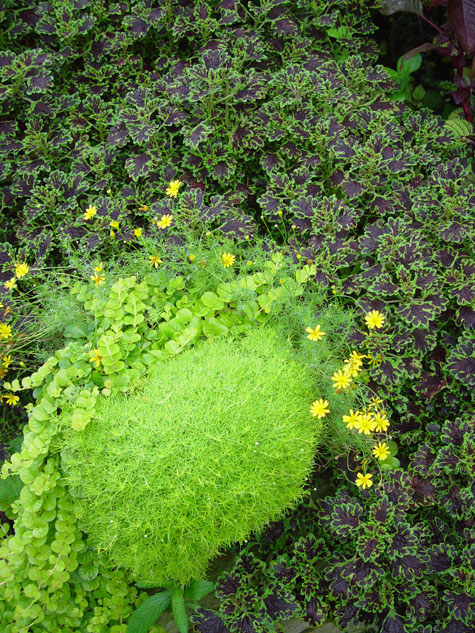 Texture can also refer to how a plant feels to the touch-who could resist touching this scotch moss? Contrasting textures can make for a lot of excitement in a planting-but even the relationship of one small texture to another can be interesting.
Texture can also refer to how a plant feels to the touch-who could resist touching this scotch moss? Contrasting textures can make for a lot of excitement in a planting-but even the relationship of one small texture to another can be interesting.  Some plantings where all the textures read similarly encourage focus on color, or mass. The choice of plants very much dictates what about a plant or planting becomes the dominant element. This box of grass, euphorbia Diamond Frost, thyme and sedum has that casual roadside weed look to it. You notice the blue of the sedum first off, as the textures of all the plants are so similar. There is a whole story here about little leaves.
Some plantings where all the textures read similarly encourage focus on color, or mass. The choice of plants very much dictates what about a plant or planting becomes the dominant element. This box of grass, euphorbia Diamond Frost, thyme and sedum has that casual roadside weed look to it. You notice the blue of the sedum first off, as the textures of all the plants are so similar. There is a whole story here about little leaves. 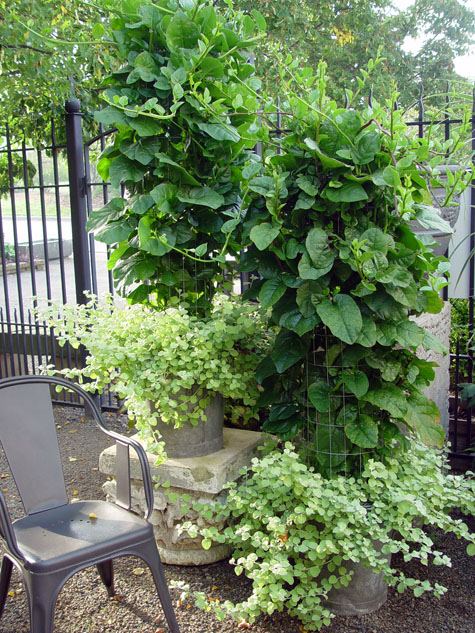 Malabar spinach has thick, substantial leaves that are glossy and wrinkled. This texture reads all the more strongly for its pairing with the diminuitive felted stems and leaves of lime licorice.
Malabar spinach has thick, substantial leaves that are glossy and wrinkled. This texture reads all the more strongly for its pairing with the diminuitive felted stems and leaves of lime licorice. 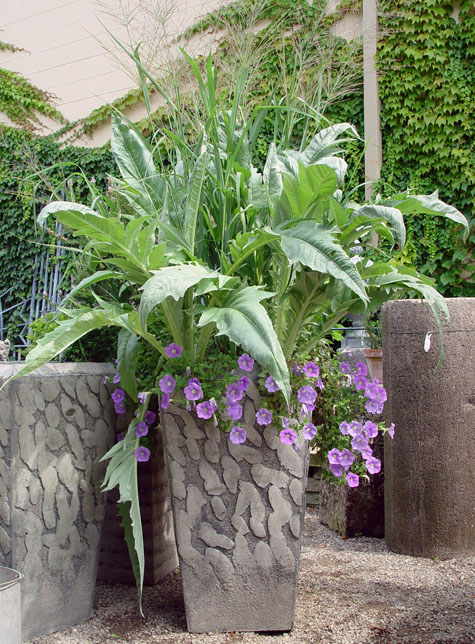 The hunky, toothy, slighting menacing leaves of this cardoon are softened by the much less architectural “Dallas Blues” panicum grass-and the so sweet blue petunias. The cardoon has a felted leaf-the panic grass is smooth and shiny. Those blue petunias are along for the ride-and soften much the architecture of the cardoon-and the pot.
The hunky, toothy, slighting menacing leaves of this cardoon are softened by the much less architectural “Dallas Blues” panicum grass-and the so sweet blue petunias. The cardoon has a felted leaf-the panic grass is smooth and shiny. Those blue petunias are along for the ride-and soften much the architecture of the cardoon-and the pot.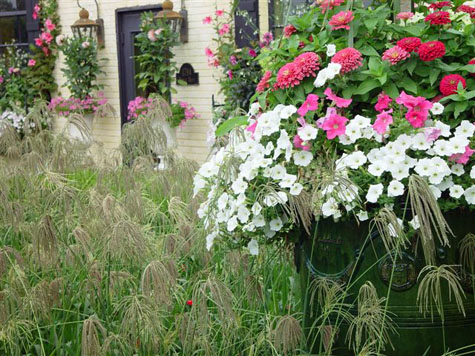 Large flowers like zinnias and petunias have a simple texture, while its companion grass has a complex, texture-like fireworks. Diametrically opposed to this delicately textured grass, caladiums and this lime dieffenbachia have leaves so thin and so wide the sun shines through them; it looks like the lights are on in this very shady spot. Identifying what about a particular plant you like will help a lot to inform your design with them. Everyone knows texture. Its the process of being conscious of it that can help make for inspired plantings .
Large flowers like zinnias and petunias have a simple texture, while its companion grass has a complex, texture-like fireworks. Diametrically opposed to this delicately textured grass, caladiums and this lime dieffenbachia have leaves so thin and so wide the sun shines through them; it looks like the lights are on in this very shady spot. Identifying what about a particular plant you like will help a lot to inform your design with them. Everyone knows texture. Its the process of being conscious of it that can help make for inspired plantings .